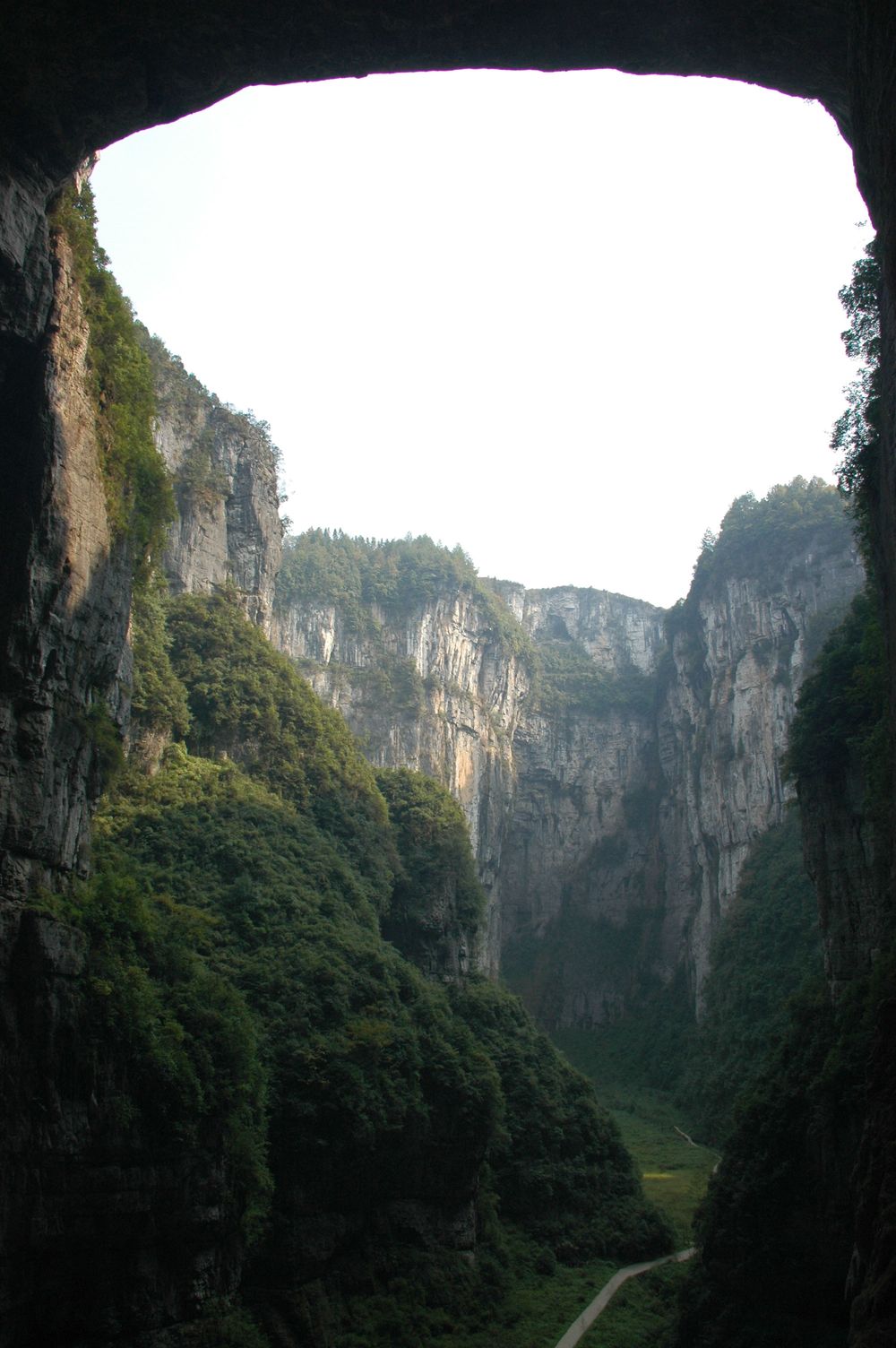Three Natural Bridges on:
[Wikipedia]
[Google]
[Amazon]
 The Three Natural Bridges () are a series of natural
The Three Natural Bridges () are a series of natural
 Spanning the Yangshui River, a tributary of the Wu River, the bridges are at the centre of a conservation area which also includes:
* Qinglong Tiankeng (青龙天坑);
* Shenying Tiankeng (神鹰天坑);
* Yangshui River Karst Canyon (羊水河喀斯特峡谷);
* Longshui Gorge (龙水峡地缝);
* Central Shiyuan Tiankeng (中石院天坑);
* Lower Shiyuan Tiankeng (下石院天坑);
* Seventy-two Branch Cave (七十二岔洞);
* Longquan Cave (龙泉洞);
* Immortal Cave (仙人洞);
* Hidden Monkey Stream (猴子坨伏流);
* Hidden Baiguo Stream (白果伏流).
Given that the distance between the upper end of the Tianlong Bridge and the lower end of the Heilong Bridge is only , these are not the longest natural bridges. However, they are the only such group of
Spanning the Yangshui River, a tributary of the Wu River, the bridges are at the centre of a conservation area which also includes:
* Qinglong Tiankeng (青龙天坑);
* Shenying Tiankeng (神鹰天坑);
* Yangshui River Karst Canyon (羊水河喀斯特峡谷);
* Longshui Gorge (龙水峡地缝);
* Central Shiyuan Tiankeng (中石院天坑);
* Lower Shiyuan Tiankeng (下石院天坑);
* Seventy-two Branch Cave (七十二岔洞);
* Longquan Cave (龙泉洞);
* Immortal Cave (仙人洞);
* Hidden Monkey Stream (猴子坨伏流);
* Hidden Baiguo Stream (白果伏流).
Given that the distance between the upper end of the Tianlong Bridge and the lower end of the Heilong Bridge is only , these are not the longest natural bridges. However, they are the only such group of
Wonders of Nature: Wulong National Geological Park
{{Chongqing Natural arches of China Karst formations of China Landforms of Chongqing Limestone formations Tourist attractions in Chongqing World Heritage Sites in China
limestone
Limestone ( calcium carbonate ) is a type of carbonate sedimentary rock which is the main source of the material lime. It is composed mostly of the minerals calcite and aragonite, which are different crystal forms of . Limestone forms whe ...
bridges located in Xiannüshan Town (), Wulong District
Wulong District () is a district of Chongqing Municipality, China, bordering Guizhou province to the south.
Administration
Climate
Education
There is a central elementary school in Baiyun Town.
Transportation
The district is served by C ...
, Chongqing Municipality
Chongqing ( or ; ; Sichuanese pronunciation: , Standard Mandarin pronunciation: ), alternately romanized as Chungking (), is a municipality in Southwest China. The official abbreviation of the city, "" (), was approved by the State Counc ...
, China. They lie within the Wulong Karst National Geology Park, itself a part of the South China Karst
The South China Karst (), a UNESCO World Heritage Site since June 2007, spans the provinces of Chongqing, Guangxi, Guizhou, and Yunnan. It is noted for its karst features and landscapes as well as rich biodiversity. The site comprises seven clust ...
-Wulong Karst The Wulong Karst () is a karst landscape located within the borders of Wulong District, Chongqing Municipality, People's Republic of China. It is divided into three areas containing the Three Natural Bridges, the Qingkou Tiankeng (箐口天坑) and ...
UNESCO
The United Nations Educational, Scientific and Cultural Organization is a specialized agency of the United Nations (UN) aimed at promoting world peace and security through international cooperation in education, arts, sciences and culture. It ...
World Heritage Site
A World Heritage Site is a landmark or area with legal protection by an international convention administered by the United Nations Educational, Scientific and Cultural Organization (UNESCO). World Heritage Sites are designated by UNESCO for h ...
. In Chinese, the bridges are all named after dragons
A dragon is a reptilian legendary creature that appears in the folklore of many cultures worldwide. Beliefs about dragons vary considerably through regions, but dragons in western cultures since the High Middle Ages have often been depicted as ...
, namely Tianlong
Tianlong (; lit. "heavenly dragon") is a flying dragon in Chinese mythology, a star in Chinese astrology, and a proper name.
Word
The term ''tianlong'' combines ''tian'' "heaven" and ''long'' "dragon". Since ''tian'' literally means "heaven; th ...
() Qinglong () and Heilong ().
Description
karst
Karst is a topography formed from the dissolution of soluble rocks such as limestone, dolomite, and gypsum. It is characterized by underground drainage systems with sinkholes and caves. It has also been documented for more weathering-resistant ro ...
structures in the world. Between the bridges lie the Qinglong and Shenying tiankengs which have a depth of 276–285 metres and a circumference of 300–522 metres.
Dimensions
See also
*Wulong Karst The Wulong Karst () is a karst landscape located within the borders of Wulong District, Chongqing Municipality, People's Republic of China. It is divided into three areas containing the Three Natural Bridges, the Qingkou Tiankeng (箐口天坑) and ...
*Furong Cave
Furong Cave () is a karst cave located on the banks of the Furong River, from the seat of Wulong District, Chongqing, People's Republic of China.
History
First discovered by local farmers in 1993 the cave was opened to tourists in 1994. It beca ...
*Xueyu Cave
Snowy Jade Cave (a.k.a. Snow Jade Cave or Xueyu Cave, ) is a National Three Gorges Scenic Area and a National 4A Scenic Area located in Fengdu County, Chongqing Municipality, People's Republic of China, not far from the Yangtze River.
Descript ...
*Tianmen Mountain
Tianmen Mountain () is a mountain located within Tianmen Mountain National Park, Zhangjiajie, in the northwestern part of Hunan Province, China.
Mountain
A cablecar was constructed in 2005 by the French company Poma from nearby Zhangjiajie rail ...
References
External links
Wonders of Nature: Wulong National Geological Park
{{Chongqing Natural arches of China Karst formations of China Landforms of Chongqing Limestone formations Tourist attractions in Chongqing World Heritage Sites in China